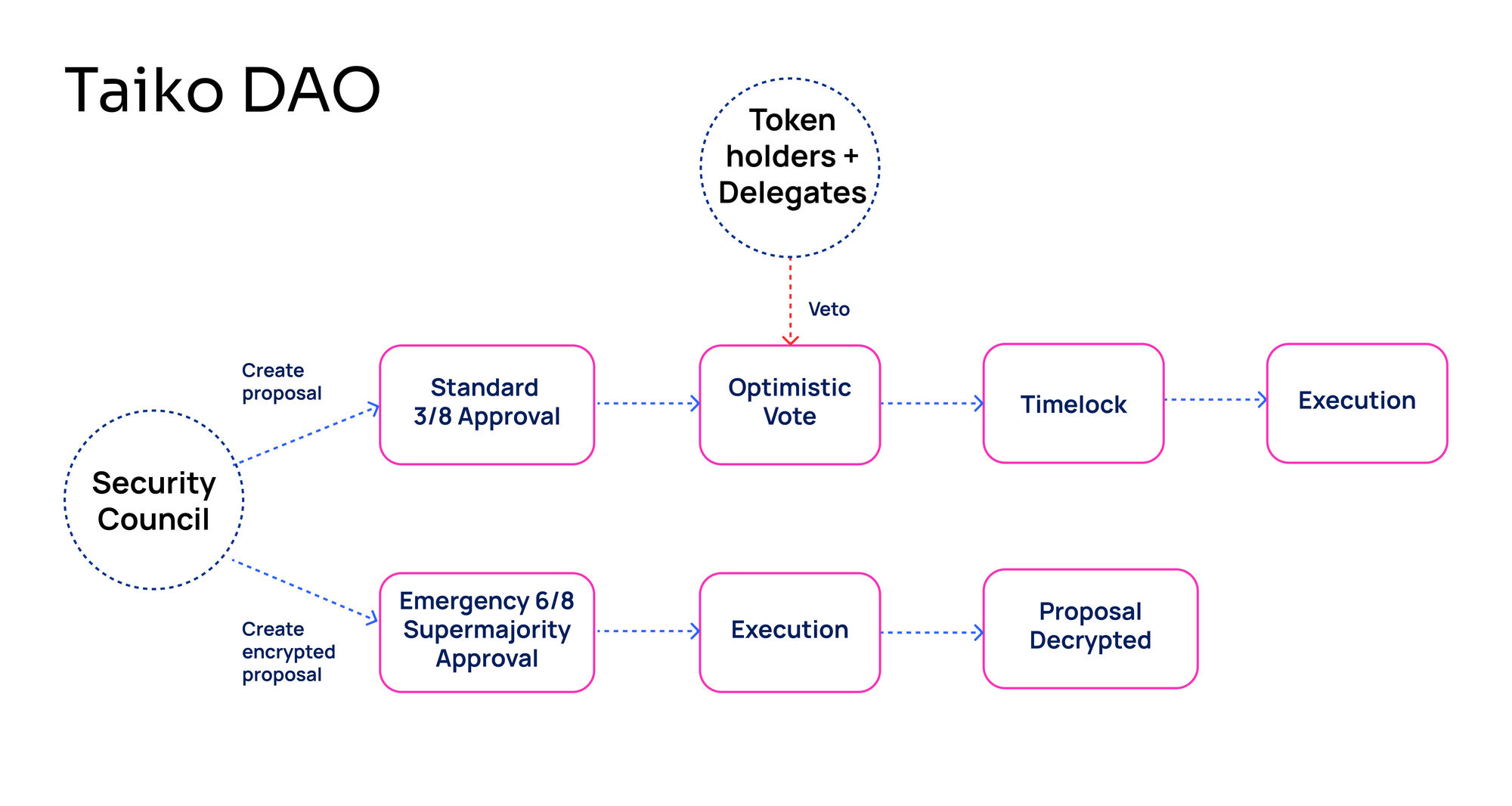Introducing Taiko’s Optimistic Onchain Governance
We’re excited to announce the decentralization and security-focused onchain governance design of the Taiko DAO. This milestone marks a significant step forward in Taiko’s governance roadmap to fully decentralized protocol governance.
TLDR:
- Optimistic governance model, where token holders have onchain veto rights;
- Security Council that can efficiently and securely propose protocol upgrades;
- Multi-threshold protocol upgrades, with standard and emergency proposal paths;
- Encrypted emergency proposals;
- Token holders can delegate their veto power;
- Consolidated governance process in the Taiko Governance Hub.
Taiko is an Ethereum-equivalent zkEVM based rollup that is open, permissionless, and requires no additional trust assumptions, as security is derived from Ethereum validators. Vitalik proposed the first block on Taiko Mainnet and has endorsed it for its advancements in decentralization for L2s.
Taiko is deeply committed to Ethereum’s core values, such as decentralization, permissionlessness, and trust minimization. This not only applies to the unique technical architecture of their rollup, but also their commitment to giving the community onchain rights in the protocol upgrade process.
Optimistic Governance
Taiko is using optimistic governance which enables a streamlined decision-making process that balances efficiency with community checks and balances. This design allows the Security Council to pass proposals, while giving token holders onchain veto rights. This means token holders can veto a malicious proposal and/or have the opportunity to exit. If a proposal doesn’t accumulate enough votes by the end of the veto period, it is automatically executed after an additional 7-day timelock. Giving token holders onchain veto rights and an opportunity to exit serves as both checks and balances and an additional security layer. It also combats voter fatigue, as voters only need to participate when a veto is needed.

Multi-Threshold Multisig
In addition, Taiko is incorporating the multi-threshold protocol upgrades inspired by Polygon. This gives the Security Council two tracks to implement protocol upgrades:
Standard Proposal
The standard proposal flow is the typical pathway for most upgrades and ensures that the Taiko community can directly engage in the governance process onchain. The process includes:
- An 8-member Security Council (to be announced) composed of internal and external members who create and approve proposals.
- 3 out of 8 approvals from the Security Council are required for a standard proposal to pass.
- A community review period where token holders and delegates have the ability to veto proposals.
- Any proposal that does not meet the veto threshold by the end of the review period is automatically executed after a 7-day timelock, giving token holders the opportunity to exit if needed.
Emergency Supermajority with Encrypted Proposals
When a critical situation arises (e.g., a major protocol vulnerability), the Security Council has an emergency process for proposals to be expedited to protect the Taiko protocol and the community. Here’s how it works:
- Just like in the standard proposal flow, any Security Council member can submit an emergency proposal.
- The contents of an emergency proposal are encrypted to prevent exploitation prior to implementation.
- The approval threshold is higher for emergency proposals, requiring a supermajority from 6 of the 8 Council members to pass.
- There is no review and veto for token holders during the emergency proposal process, since the proposals are encrypted for security reasons.
- Finally, the proposal contents will be decrypted and made public to maintain accountability and transparency when executed.
Taiko Governance Hub
The Taiko Security Council and community can participate in the governance process on the Taiko Governance Hub. For the Security Council, both standard and emergency proposals can be submitted via the Governance Hub. Token holders can either delegate their veto power or veto directly in the Hub as well. The Governance Hub is custom branded for the Taiko community and will evolve with Taiko’s governance.
The Taiko DAO is live on the Hekla testnet for rigorous testing. With a genuine binding onchain governance system in place, voters will be able to directly influence the development of Taiko’s infrastructure. Feedback is welcomed prior to mainnet deployment. The best way to get involved in the discussion is to join Taiko’s Discord server.
The Taiko DAO is built to meet L2Beat’s Stage 1 criteria when launching on mainnet. Aragon’s governance solutions are ideal for L2s looking to become more decentralized, while balancing security considerations, and meeting industry best practices.
Whatever solution your DAO requires, building with Aragon OSx means that your governance systems can continue to evolve without compromising on security or reliability. To learn more about how we can help, reach out.
